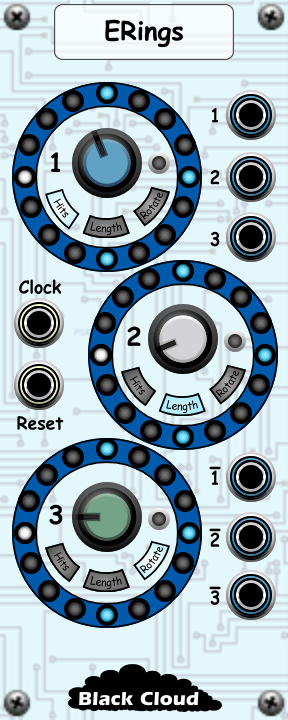
In 2004, computer scientist Godfried Toussaint discovered that evenly distributing events around a circular sequence produced rhythmic patterns that followed an algorithm first described by Euclid in ~300BC. These patterns, while mathematically generated, turn out to be very common in traditional musical styles from around the world. The Brazilian Bossa-Nova and Samba, and the Cuban tressillo and cinquillo are just a few of the many rhythmic patterns that follow the Euclidean recipe.
ERings is a three-channel, 16 step Euclidean Sequencer that you can use to explore the rhythms of the Euclidean space.
- Individually adjustable sequence length (1-16 steps), number of “hits” (1-16) and rotation amount (0-15 steps) controls for each channel.
- Shared Clock (trigger) and Reset (gate) input. Clock inputs are ignored while the Reset gate is high.
When clocked, Outputs 1, 2 and 3 generate trigger pulses for the corresponding channel if the current step is a “hit” while Outputs Bar 1, Bar 2, and Bar 3 generate an inverted pattern, emitting trigger pulses for the corresponding channel if the current step is not a “hit”.
A PDF format “Quick Reference Guide” is available here: http://www.blackcloudmusic.ca/wp-content/uploads/2022/10/ERings-Instructions.pdf
Godfried’s paper on Euclidean rhythms (“The Euclidean Algorithm Generates Traditional Musical Rhythms“) http://cgm.cs.mcgill.ca/~godfried/publications/banff.pdf
The visual style for ERings comes from Vladimir Pantelic’s “Euclidean Circles” euro-rack module: https://vpme.de/euclidean-circles/